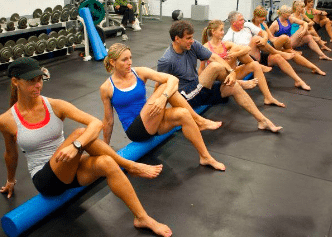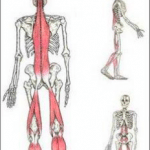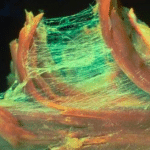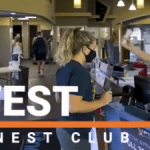The Wonderful World of Fascia: A beginners guide to self myofascial release

By: JohnLoDrago, Senior Fitness Trainer at Fitness CF Clermont
Anyone who knows me understands how strongly I feel about preparing your muscles, ligaments, and tendons prior to working out. As part of a good mobility Warm up before exercise, I Perform a soft-tissue mobilization technique called self-myofascial release (SMR).
SMR is a popular form of self-massage used to reduce soft-tissue stiffness, aid post-workout recovery, and maintain normal muscular function.
Although many of these techniques originated in the rehabilitative setting, SMR has gained a lot of popularity with fitness professionals over the last decade. In most health clubs, foam rollers and massage balls are as common as treadmills and dumbbells.
Despite the growing popularity of SMR techniques, I still find that most people are confused about its proper place in their strength and conditioning program. Is it a simple matter of gyrating your hips against a cylinder of hard-foam for a few minutes at the beginning or end of every workout? Or is there more to it that you should know?
It turns out there is quite a bit more to understand the important role that SMR plays in your overall health and musculoskeletal function. And there’s no better place to start than getting to know one of the most abundant substances in your body – fascia.
If you understand fascia, then you understand that a lot of what we thought we knew about the musculoskeletal system was wrong. Muscles are not isolated entities with clearly defined borders and individualized functions. Our musculoskeletal system is just that: a system of systems, linked together by a highway of connective tissue we call fascia.
Fascia penetrates and surrounds every muscle and organ in our body. It links together muscles, and groups of muscles, from the top of our skulls (epicranial fascia) to the bottom of our feet (plantar fascia).

It is made up of tightly packed collagen and elastin fibers, woven together like the fibers of a sweater, that reside in a gel-like bath called ground substance. A ground substance has the unique ability to go from gel to liquid-form in response to pressure, heat, or stretch.
Fascia also contains specialized cells called fibroblasts, which give it the ability to produce more fascia. This usually occurs along lines of mechanical stress as a sort of reinforcement mechanism. You see this happen a lot, especially in the upper/middle back of office workers.
Fascial tissue also contains smooth muscle cells and proprioceptors embedded within its cellular matrix. These give it the means to not only sense stretch and positional change, but the ability to contract or relax in response to it as well (another thing that we thought only muscle could do). Fascia contains up to nine times as many mechanoreceptors than regular muscle tissue.
The two main types of proprioceptors in fascia are Ruffini and Pacini endings. Ruffini endings decrease muscle tone and inhibit sympathetic nervous system activity in response to stretch or direct pressure. Conversely, Picini endings tense your muscles in response to pressure or vibration, providing joint stability throughout the body.

Unfortunately, the qualities that make fascia so dynamic also make it susceptible to deformation. Fascial tissue that is repeatedly exposed to excessive strain can become dense, knotted or otherwise stuck together.
These areas of increased tension and are called adhesions. These adhesions can cause your muscles to lose independent movement, dragging their neighbors along with them for every movement.
Adhesions often develop around the site of the previous injury and in areas of high mechanical stress like the upper back, neck, rotator cuff, gluteus, and calves. They often cause decreased blood flow, are painful to the touch, and alter normal posture.
Fortunately, there are a number of excellent myofascial release techniques to choose from to keep these adhesions at bay. Myofascial release is a manual therapy technique in which gentle, sustained pressure is used on the soft tissues while traction is applied to the fascia. This technique results in softening and lengthening of the fascia and breaking down of scar tissue and adhesions between skin, muscles, and bones.
My name is John LoDrago and I have been a certified personal trainer, fitness and nutrition coach for over 25 years. I hold many certifications and have created a number of team training group programs, such as Little Champs Core Camp summer program. I was the owner and operator of a nutrition and retail café called Re-Fuel, “Nutrition that Drives You” for over 10 years, and have competed as a natural bodybuilder, winning the 2001 NYS Masters overall championship. I write customized menu plans for sports performance athletes, and stage competitors, and was a regular guest speaker on the radio talk show Forever Healthy in Syracuse, New York. A little over seven years ago my family and I made the move to Clermont, Florida where I started working for Fitness CF, formerly Gold’s Gym. While in Florida I have been involved in helping build a team of trainers at the Mount Dora location and have had the pleasure of working with some of the most knowledgeable and amazing people in the industry. My goal in life is to pass on the knowledge I have learned to those who seek a healthier way of living and to always remember that life will take on purpose only when you bring purpose to others.
I am currently The Senior trainer at Fitness CF of Clermont FL. And hold certifications by the National Sports Conditioning Association, N.S.C.A. C.P.T., CHEK Holistic Lifestyle Coach, PN Lv.1 Nutrition Coach, Neurokinetic Therapy, A.F.A.A. P.T./ Fitness Counselor and Resistance Trainer, APEX Nutrition Certified, Power Plate Lv.1, and Golf Academy, PiYo, Silver Sneakers M.S.R.O.M. Less Mills Grit Coach, Total Gym Gravity Coach.
If you have a question and/or topic you would like me to discuss please e-mail me at [email protected]





